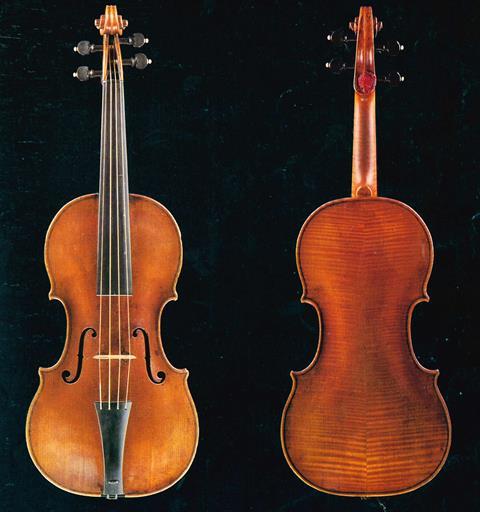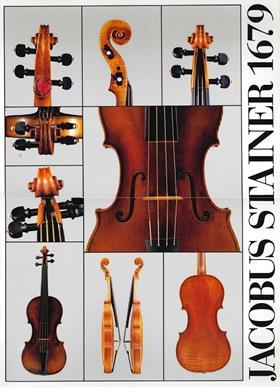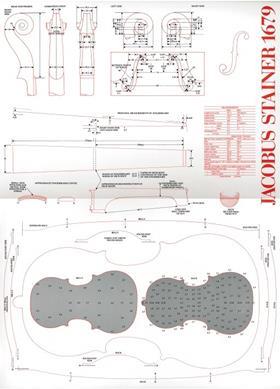In this article from the April 1990 issue of The Strad, Roger Hargrave examines the construction and workmanship of this violin, which still retains its original undisturbed baroque neck

Experts seem to agree that Stainer learned his trade in Italy. And although this agreement mostly rests on analogies of Stainer’s work, it is also known (from his writings) that he was familiar with the language. Furthermore, there are several oral traditions relating to an Italian apprenticeship. As might be expected however these oral traditions are contradictory, on the one hand saying that Stainer worked in Venice and on the other that he worked in Cremona.
…
For what my own opinion might be worth, the style, method and above all the varnish of Stainer point most definitely towards Cremona.
…
At the time of Stainer’s supposed apprenticeship only Nicolo Amati could have been regarded as a possible teacher for Stainer in Cremona … Certainly the similarity between some of Stainer’s instruments and those of the Amati, are so strikingly obvious that it is difficult to imagine any other possible source for Stainer’s inspiration … Quite apart from certain structural comparisons which can be made, between Stainer’s work and that of the Cremonese School, few violin makers ever succeeded in producing instruments of such aesthetic beauty. The superb curving lines, the sculptural depth and the delicate craftsmanship of Stainer’s instruments are the epitome of the baroque. I would maintain that in this respect alone Stainer at his best comes closer than any other classical maker to the Amati ideal. There is, however, no mention of Stainer’s name in the Cremona archives and so, once again, we can do little more than speculate.
…

By the latter half of the 17th century, in his own lifetime, Stainer’s reputation had reached remarkable heights. Around 1658 he was even supplying instruments to the Spanish court. For the next 150 years Stainer’s instruments were considered the non plus ultra.
…
It was the changes in musical tastes, technique and technology, towards the end of the 18th and into the 19th century, which were mainly responsible for Stainer’s fall from grace. The works of Stradivari and Guarneri were somewhat better suited to these changes.
…

This 1679 violin by Jacob Stainer is one of the few Classical violins which have never been converted to modern playing specifications. No similar violin is known to exist from the ‘accepted’ Cremonese school. Remarkably after over 300 years this instrument still retains its unaltered original neck fingerboard and bass bar.
…
The outline of this instrument is only one step removed from the Amati concept. The curves are generally broad and open, especially the C-bout curves and there is that distinctive Amatese flatness across the top and bottom blocks. The archings are very reminiscent of the Brothers Amati, in their well scooped edges, although this particular arching is much flatter across the top than any Amati arching would be. This flatness gives the arching that characteristic boxy Figure of Eight fullness which is usually regarded as Stainer’s trademark.
I have seen instruments by Stainer, where the archings, the outlines and the purfling of the backs so much resemble the work of Amati that it is only an extremely clever eye that can distinguish them before the belly has been seen. This particular two piece back is cut on the quarter and has a med to tight figure. The growth structure … is quite wide. Stainer used a variety of maple backs. His two piece backs are often joined in the Amati style with the flame continuing across the centre joint in the same direction. Stainer also used one piece backs cut on the quarter, the slab and sometimes even the half slab. Only rarely can the flame or figure be described as wide.
…
Very unlike the Cremonese school is the treatment of the edgework on the underside of the plates. On this instrument the rounding off is extremely even with no sign of the knife cut chamfer, which usually remains to be seen on all clean Cremonese instruments. This cleanly rounded underside to the edgework seems to have been a regular working practice of Stainer’s. The upper edgework is, however, finished in the Cremonese style.
…
We now turn to the belly. Two pieces of even, straight grained pine, of medium growth widening slightly in the flanks. It is the type of wood which Stradivari seemed to prefer in his late period. Stainer sometimes used belly wood of extremely fine growth, of a type seldom seen in Cremona and which we normally associate with the Mittenwald School. Here again the edgework is in a very good state of preservation with only the corners and the chin area showing any real signs of wear and tear. An interesting feature of this belly is that the purfling runs through underneath the fingerboard. This feature can also be seen on the Messiah Stradivari, where the modern neck has not been let in as deeply as would normally be the case.
…
I have left until last the question of Stainer’s varnish. In the final analysis it is the quality of the varnish which makes or breaks the product. Usually it is the varnish on Stainer violins which, at a glance, distinguished them from those of his copyists, placing him firmly in the ranks of the Cremonese masters and in particular alongside the Amati family. The varnish on this instrument is, however, a little unusual. It is of an orange brown colour and has been extremely thinly applied. It is present in large amounts and it is in a very pure state of preservation. But it is not what most people would consider a classical varnish. The process of polishing varnish lifts the refractive index, effectively making it more transparent. It also raises the intensity of colour. Too much polishing breaks down the surface texture and creates a glassy coating, which reflects the light almost before it has had the time to penetrate down to the wood. Unfortunately, the vast majority of classical instruments have been overpolished, usually with a thick layer of shellac. Simply because pure unpolished instruments are so extremely rare, they are often not recognised by the inexperienced eye. This is one reason why the ‘Salabue’ Stradivari, 1716, better known as ‘Le Messie’ is often denounced. The Stainer violin illustrated here falls into this category. Although it takes a practised eye to appreciate the full beauty of this mercifully unpolished varnish, it is certainly worth making the effort.



































No comments yet